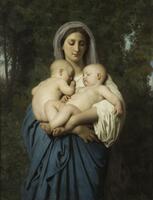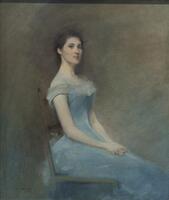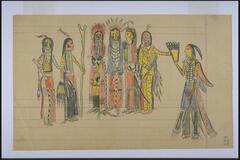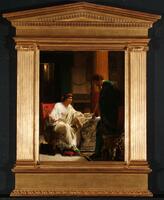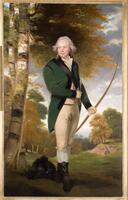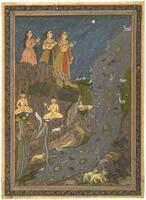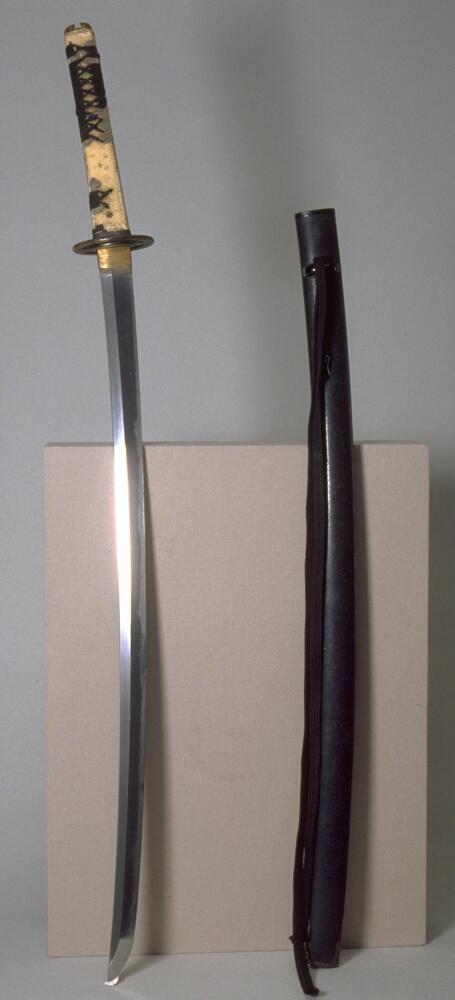Essay: Samurai Armor
Background: Japanese Armor
As fighting strategies and weapons changed, armor, or yoroi, was modified to protect the samurai from injury and death. However, in the Edo Period (1603-1868), a trend developed that adopted the aesthetics of the past, rather than the most recent protective technology. By the time this armor was made, Japan had been at peace for about 200 years. Armor was displayed more as a statement of power and artistic taste than as protection. Still, this suit would have been quite functional if it were ever pressed into service.
Each suit since roughly the 11th century was made of multiple tiny plates of lacquered metal sewn together with silk thread. These plates acted much like chain mail, but were more lightweight and somewhat more flexible depending on the design of the suit. Beginning in the 13th century, arm and leg guards were added to the basic suit and helmet ensemble. As swords and, later, arquebuses (early flintlock firearms that resembled rifles in appearance) replaced the bow and arrow as the main weapon in combat, chest and neck protection became more important. The helmet itself underwent a change when Tokugawa Ieyasu suggested that it should be made of iron, to do double duty as a cooking vessel for samurai at camp. Face guards became more important when hand to hand individual duels became the most honorable form of fighting.
Red and black were the preferred colors for lacquer. To distinguish each other on the battlefield, opposing armies carried banners and wore crests. The banners that 16th century armies carried were a simple modification of the capes worn by Heian, Kamakura and Ashikaga shogun and daimyo. Footwear remained limited to straw sandals, leather soled boots or bare feet.
Armor was very expensive, yet as part of the Tokugawa Edicts enforcing alternate residency (in which daimyo, or head samurai over a particular region, maintained residency in Tokyo for six months of the year and six months in their home province), each daimyo was forced to maintain a well-stocked, fully prepared army. Therefore, each samurai in the service of a lord had at least some armor. The richer daimyo and samurai could afford lavishly decorated, elaborate suits whose details recalled previous eras.
Yoroi also emphasized the personal style of the wearer. If a daimyo was particularly fond of a samurai of the past, then some of the more prominent markers of that suit would be added. Embossing was another decorative option. This helmet’s distinctive crescent moon ornamentation is in tribute to Date Masamune (1566-1636), the “one-eyed dragon,” faithful retainer of Tokugawa Ieyasu and daimyo of Sendai, in the western portion of Honshu. Many helmets had some version of this crescent shape, which was meant to deflect sword blows, although few were quite as contoured or smooth.
Object Information: UMMA Armor
UMMA’s suit of armor is made following traditional techniques. The shin guards, chest protector and gloves are smooth sheets of lacquer, while the thigh, neck, arm and hip guards are made of a lacquer loom and multicolored silk thread. This basketlike structure prevents swords from penetrating the suit. The helmet is made of iron, appropriate for cooking meals while on the battlefield. The ear flaps are wide and sweeping, reflecting its date of creation after the introduction of swords as weapons in combat. The belt, made of silk, carries a long sword (the one we normally recognize today as a “samurai” sword, either a katana or a tachi), a shorter sword paired with the longer one and known as a wakizashi and, sometimes, a daggerlike sword called a tonto.
Object Information: The Mon (Crest) and the Paulownia
This suit depicts a mon (crest), similar to a coat of arms, representing the paulownia tree on the chest protector and stand. Aristocrats usually held mon, although permission to use a master’s mon as one’s own could be granted to a lower ranked individual as a reward for service. Families devised their own mon, which was passed down to all the sons. They were prominently displayed on clothing and banners – the more mon on a kimono, the more formal it was. The basic mon was always black and white; any color could be used to enhance it.
The Paulownia was adopted as the family crest of Toyotomi Hideyoshi, one of the three heroes of the civil wars that led to the unification of Japan in 1603. Paulownia was considered one of the twin symbols of the Japanese throne as well, along with the chrysanthemum. The Paulownia tree is a symbol of princesses. Traditionally, when a daughter was born, a father would plant a paulownia tree in his yard. When the daughter married, the father used Paulownia wood for her wedding dresser. This custom was not limited to royal daughters or the aristocracy. Paulownia trees grow quite fast and today it is commonly used in reforestation efforts, because they withstand temperature extremes well and can grow in poor soil.
Paulownia crest image on armor, roughly corresponding to the mon of Toyotomi Hideyoshi. It is similar to the mon used today for the Prime Minister’s office.
About the Sword
All samurai were required to wear
swords in public as a symbol of their status.
On a personal level, the sword was integral to the samurai’s identity. This
sword is made of four parts: the blade, which dates to the late 14th
or early 15th century, and the scabbard, handle and sword guard,
which all date to the 19th century.
Note that the sword does not date to the same period as the suit –
swords could be, and often were, inherited. The blade (a tachi, which is slightly longer and more curved than the katana that most people are familiar
with) consists of a soft iron core and a hard steel skin, which allows for both
flexibility and durability. The skin is impressive,
made of layers of steel folded on top of each other.
Mokume gane (木目金) literally means “wood eye metal”. The technique was developed in the 18th century as a way to create ornamental designs on metal that would not rub off easily, as painted designs would. The name derives from the appearance of the metal, which would show pockets of carbon surrounded by colored metal.
The scabbard, or sword holder, is made of either lacquer or lacquer-coated wood. While often plain black, on occasion a scabbard would be decorated with the samurai’s mon. The handle is two pieces of wood, bone, ivory or other substance. When the sword is forged, the unsharpened handle end has three holes of varying sizes punched in it. The two halves of the handle fit into these holes, and are then wrapped together with braided fabric. If a menuki is present, it too would be held in place on the sword handle by the woven fabric.
About the Donor
This suit was a gift from California Angels and New York Yankees pitcher and University of Michigan graduate Jim Abbott. Abbott was born without a right hand, yet he played baseball professionally for ten years. He was enormously successful and won an Olympic gold medal. In April 2008 he was granted an Honorary Doctor of Laws from the University of Michigan. He received this suit of armor as a gift from Gifu Prefecture as part of a goodwill tour in December 1989, and donated it to the Museum in 2006.
Resources (Armor)
Turnbull, SR. The Samurai: A Military History. Macmillan Publishing, 1977. An unusually entertaining account of the samurai, from their beginnings as servants of the local lords to their end as neglected heroes of a past era. Illustrated and thorough.
http://eos.kokugakuin.ac.jp/modules/xwords/entry.php?entryID=271 - the Encyclopedia of (Shinto) Shrine Architecture, which has a concise explanation of the kirimon (paulownia crest):
The paulownia crest or kirimon likewise was for many years used as an imperial symbol, but it was favored by the warlord Toyotomi Hideyoshi, and shrines in many areas were thus granted the crest called Taikōgiri or the "Hideyoshi paulownia." Today, most of these crests are so-called "five-three paulownia" crests, referring to the arrangement of five and three blossoms in the design. (NOTE: Ours is a “five-three”; the Prime Minister’s is a “seven-five”) Accessed 5/27/08
Resources (Sword)
The Bizen Osafune Japanese Sword Museum: http://www.city.setouchi.lg.jp/~osa-token/english/bizen/index9.htm - lots of pictures, very little text. Accessed 6/27/08.
Binnion, James, and Chaix, Bryan. “Old Processes, New Technology: Modern Mokume Gane.” Presented at the Santa Fe Jewelers’ Conference in 2002, this paper covers both modern and Edo-period mokume gane technique of metallurgy. Today, mokume gane is used extensively in jewelry. A copy will be made available to docents.
Created For
K-12 EducatorK-12 Student
Museum Visitor
UMMA Docent
UMMA Staff
University Faculty
University Student
Rate this Resource
AVG: 0 | Ratings: 0
& Author Notes
Creative Commons by-nc-saLast Updated
April 16, 2018 3:30 p.m.Report
Reporting Policy
